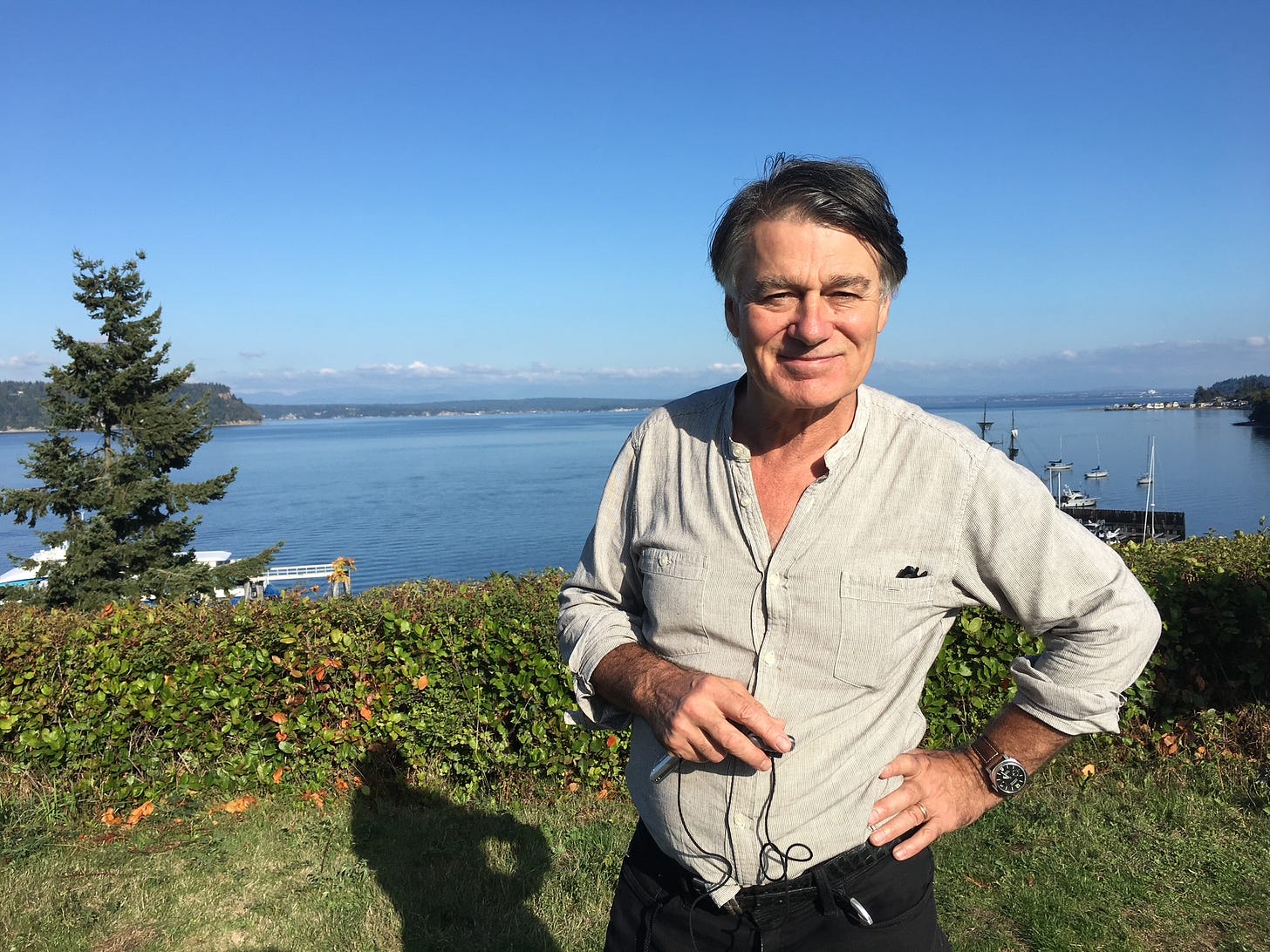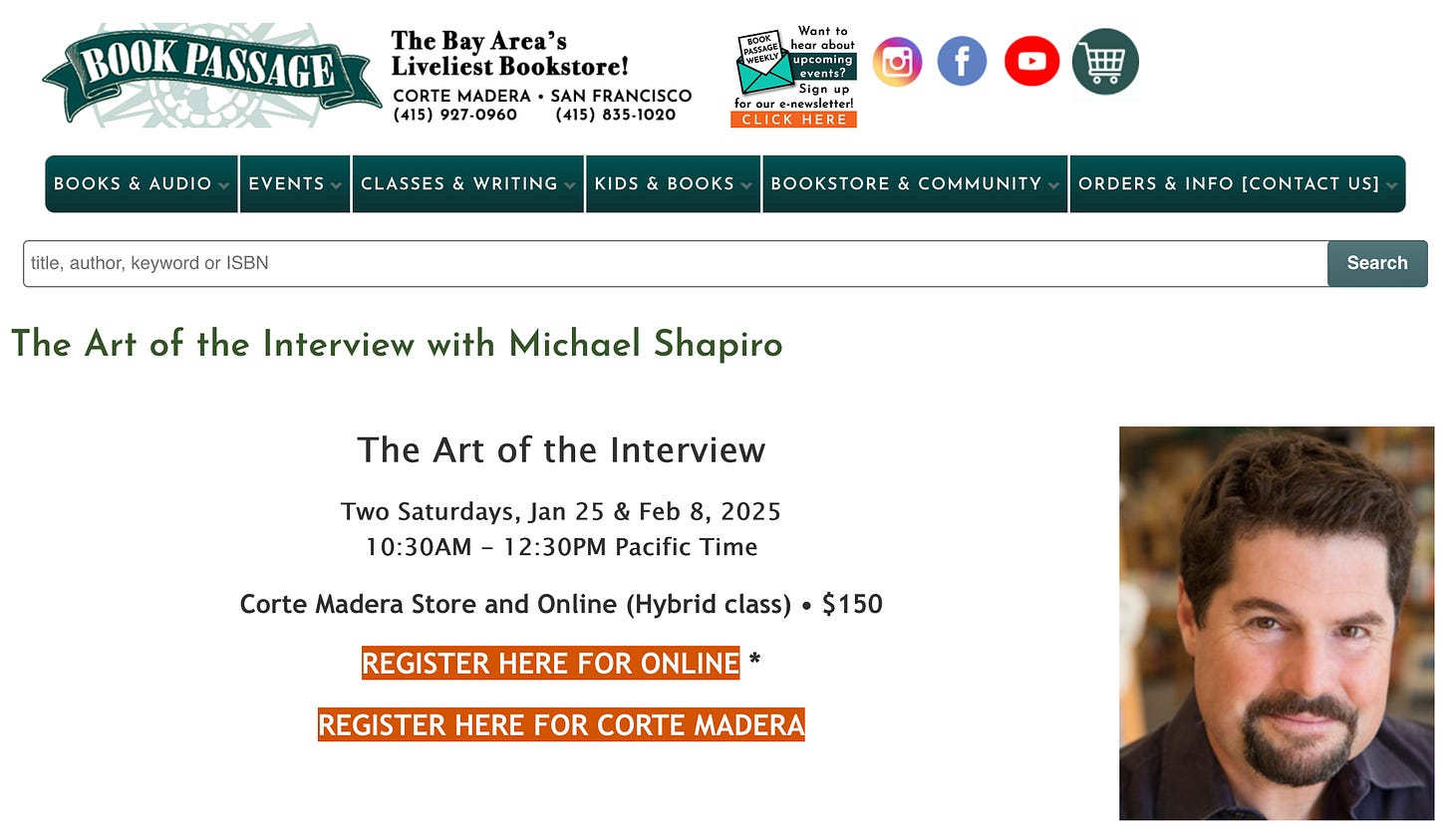The Art of the Interview
Conversations with photographer Bob Holmes and poet David Whyte. Also: Shapiro to offer two-session class about interviewing, Jan 25 and Feb 8
Hi everyone,
I’ll be teaching a class at Book Passage bookstore about the craft of interviewing, both in-person at the Corte Madera store, and online via Zoom. It’s a two-session class, on Saturday Jan 25 and Saturday Feb 8. A description of the class at bottom or click here for details.
In other news, I’ll be reconnecting with dear friend Pico Iyer for an online conversation on Jan 30 about his new book, Aflame: Learning from Silence, which is coming out next month. Details to follow next month.
Here are two interviews of note, one from this month, the other from 2019.
A conversation with Bob Holmes at Book Passage, with video link
For more than 20 years, I’ve taught at the Book Passage Travel Writers and Photographers conference where Bob Holmes chairs the photography track. I’ve long admired his photos, but until his book, Passages, came out last August, I hadn’t fully realized how adventurous and pioneering he’d been.

Bob used his camera and his wits to liberate himself from a dreary British upbringing and a job in a city planning office. Starting in the 1960s, he traveled extensively in the Sahara, the Karakorum, across Nepal to Everest, places whose names alone quicken one’s pulse, and throughout India and the country formerly known as Burma. His landscapes are gorgeous — I also appreciate are his portraits; you can see that the people he photographs trust him.
The book’s designer emailed me ahead of our conversation to remind me that photography has only been around for two centuries, so Bob has been working for a significant proportion of that time.
“About three-quarters?” I asked him at the event. The thick-skinned Brit had asked me to ask hard questions, but that was not easy to sustain as his work is admirable.
Our friend Tim Cahill, a founding editor of Outside magazine, nailed the essence of Bob in the foreword to Passages: “He just takes pictures. But he obsesses about those photos. He obsesses when he's taking them and when he's editing them. He obsesses about them after they've been published. And the thing about obsession is that it's a damn good mnemonic device. He can look at one of his photos and know whether he was tired at the time, or fearful, or suffused with joy. He can smell the smells and taste the tastes. It's fair to say he has a photographic memory.”
Click here to watch a video of my conversation with Bob at Book Passage, recorded by Lori Wright on Dec 7, 2024.
My unpublished interview with poet David Whyte
Here’s an excerpt from an interview that hasn’t been published, with poet and author David Whyte. It was for a literary magazine, but right before I went to interview Whyte a new assistant editor emailed me to say, “We’d like you to stay away from his writing process and larger analysis of his poetry.” The magazine still wanted me to interview Whyte, just not about poetry. That’d be like interviewing Shohei Ohtani and not asking him about baseball.
I went ahead with the interview and met Whyte at his home on Whidbey Island, a 20-minute ferry ride from Seattle. We spoke for about three hours, first in his study, then despite his recently sprained ankle, on a walk into the hills above his home and down to the harbor.

Here’s is the beginning of our interview, my questions are in italics:
Shapiro: In your poem, “Self Portrait,” you say, “I want to know if you belong or feel abandoned, if you can know despair or see it in others.” What I find fascinating about this poem is that you’re not explicitly telling us about yourself. You’re inquiring about another. It seems to be a poem about seeking, relationship, questioning, and starting a conversation. So how is this a portrait? And what are you saying about yourself?
Whyte: Well, the poem came from an experience of seeing a whole series of self-portraits in the van Gogh Museum in Amsterdam. The museum is a terrible building actually, it doesn’t fit the paintings at all, but the one place where it works is this ramp with all of his self-portraits as you walk up. So you get to walk up and see this series of portraits of a man who had great difficulty in life. He had mental difficulties. He was barely hanging on at times. And not hanging on many times, including the time where he lost his wits and cut his ear off and sent it to the woman he’d fallen in love with in the local bordello. And then you get the self-portrait of him with the bandage around his head. There was something courageous and unflinching, especially that portrait where he is really saying, This is what you look like when you go a bit too far and cut your ear off.
I was just so moved by it. I walked back to my hotel — this was back in the ’90s when hotels used to have stationery. I sat square to the paper and wrote “Self Portrait” across the top. I thought, you must be able to do exactly the same thing in writing. On the surface I thought I might start the bridge of my nose or my eyebrows, but this other deeper question came out.
“It doesn’t interest me if there is one God or many gods, I want to know if you belong or feel abandoned, if you can know despair or see it in others.” So that was like looking at myself asking the beautiful and disturbing question. It’s a question for everyone though, and it’s a question that’s directly from the body. It doesn’t ask you what ideas you have about life or god. It just asks a direct question about something that everyone has a direct experience of, which is whether you feel you belong or not.

If you are prepared to live in the world with its harsh need to change you, this is kind of a frontier experience of looking out and looking in at the same time. And the poem goes from there and finishes with that very fierce ending: “If you are willing to live day by day with the consequence of love, and the bitter, unwanted passion of your sure defeat, I have heard, in that fierce embrace, even the gods speak of God.”
[The poem starts] “It doesn’t interest me if there is one God or many gods.” That was a really radical first line when you think that for thousands of years, thousands of people have been killing one another over that supposition. And I realized if I was to get a self-portrait and the essence of myself, that question really bored me. It’s quite tedious really. That’s someone else’s question that’s being fired like an arrow into my body. But it’s not mine. I said to myself, how many other questions am I carrying that are other people’s questions, not my own. As in most poems, it’s dropping down in the gravitational field to the center of the body’s experience and speaking from that place.
How did you go from there to identifying the questions that really were your own?
Well, I do think that the art of shaping a more beautiful mind is the act of asking more and more beautiful questions. And that you shape a more beautiful mind just by the act of asking beautiful questions, without necessarily having an answer to begin with. By asking them in a sincere way, they’re a kind of invitation for the world to come and meet you on its own terms, for you to get out from under yourself and get beyond yourself and meet the world. So I have a whole body of work now around asking the beautiful question. Solace, the art and practice of asking the beautiful question. Solace, not as false comfort, but of being in conversation with something larger than the wound that has struck you.
* * *
Lastly, here’s more info about my upcoming class, The Art of the Interview, Jan 25 and Feb 8 at Book Passage
A successful interview is an essential building block for all kinds of writing, from novels to journalism. Whether you’re writing a book, researching a newspaper or magazine story, or making a video with an elderly family member, an insightful interview combines preparation, thoughtfulness, compassion and spontaneity. In this class we’ll discuss the steps that lead to a successful interview:
— how to prepare
— how to thoughtfully ask and answer questions
— how to keep an interviewee interested, especially if it’s someone who is often interviewed
— how to customize questions to put your subject at ease and elicit fascinating and compelling answers
Being a good interviewer involves listening in an open-hearted way, without judgment, skills that go beyond interviewing and lead to richer and more rewarding relationships with friends, colleagues and potentially anyone you meet.
At the end of the first class, we’ll pair up and interview one another in the style of Humans of New York, a popular site and book. In these conversations, the interviewer seeks to quickly reach the essence of what makes someone tick, what is most meaningful to them, and what makes them unique.
When we reconvene for the second session, we’ll share segments from our interviews and discuss our process: how we got past any discomfort about asking questions of someone we didn’t know, what succeeded, and notes for next time.
During four decades as a journalist, Shapiro has interviewed Barbara Kingsolver, Amy Tan, Francis Coppola, David Sedaris, Jan Morris, Paul Theroux, Smokey Robinson, Joan Rivers, Bill Bryson and many others.
Among his most gratifying interviews have been several conversations with Jane Goodall for stories in publications including The Explorers Journal, O the Oprah Magazine, Earth Island Journal and National Geographic.
To sign up for the interview class, please click here.




